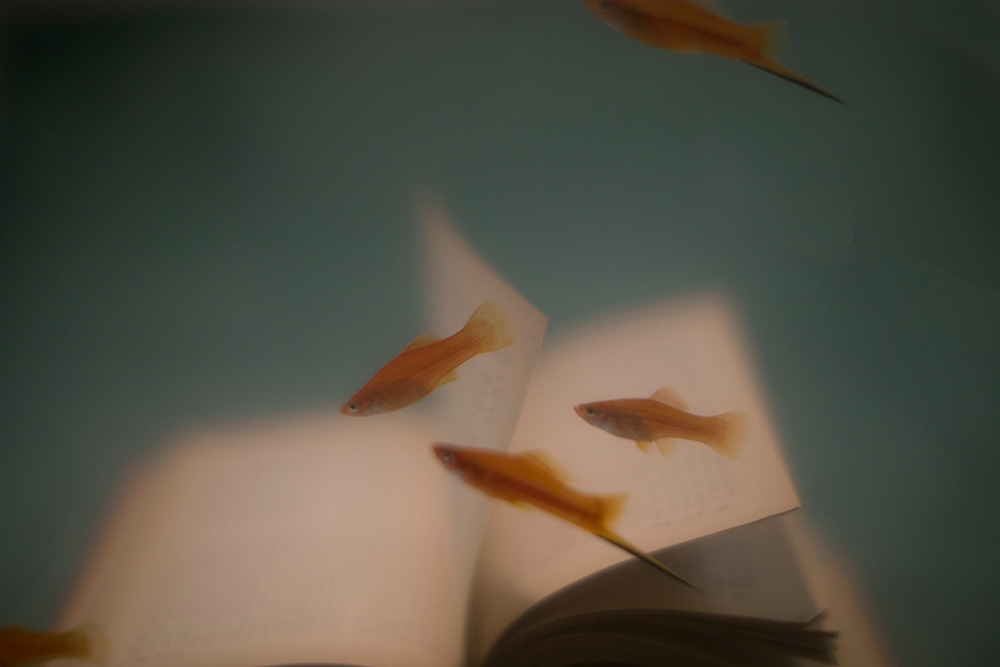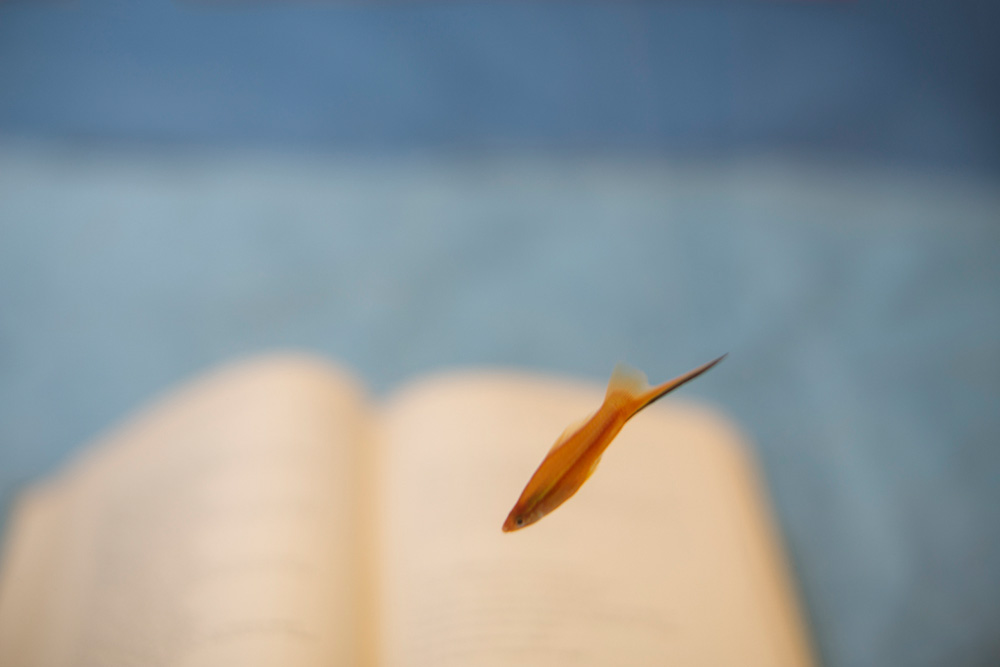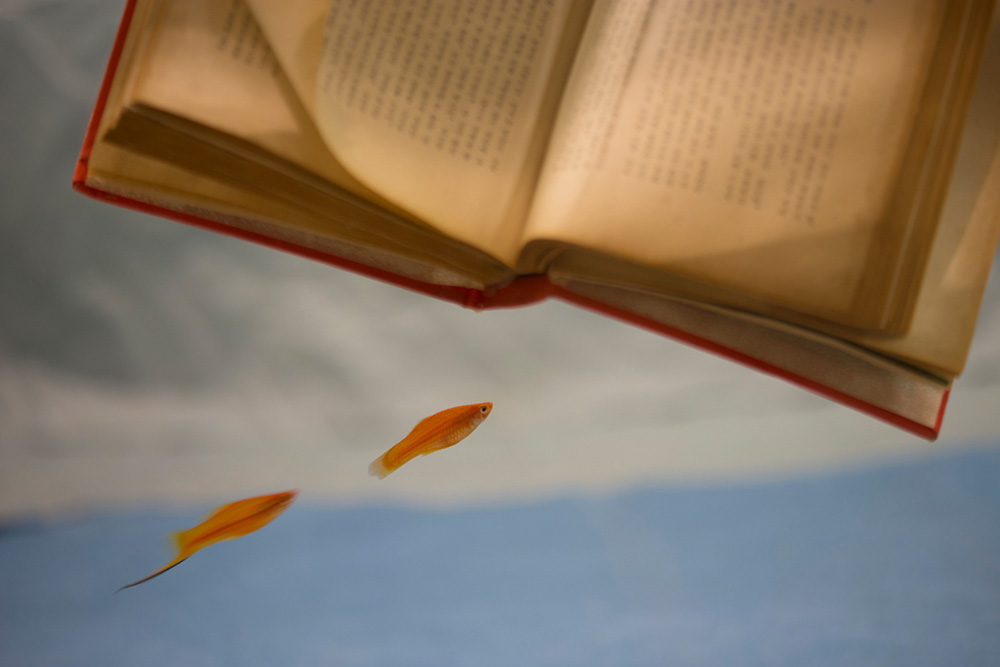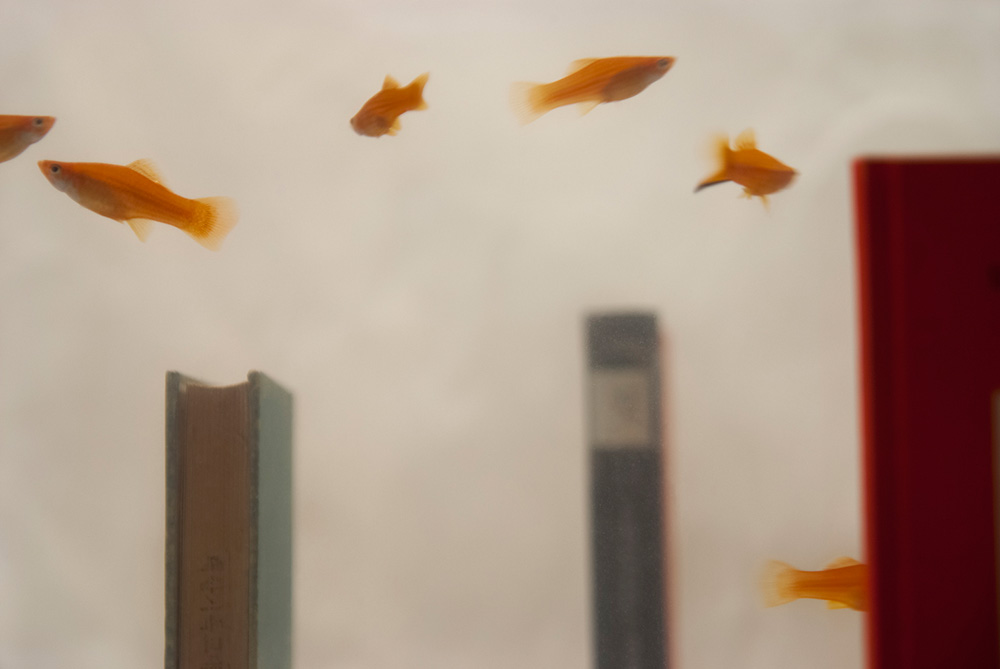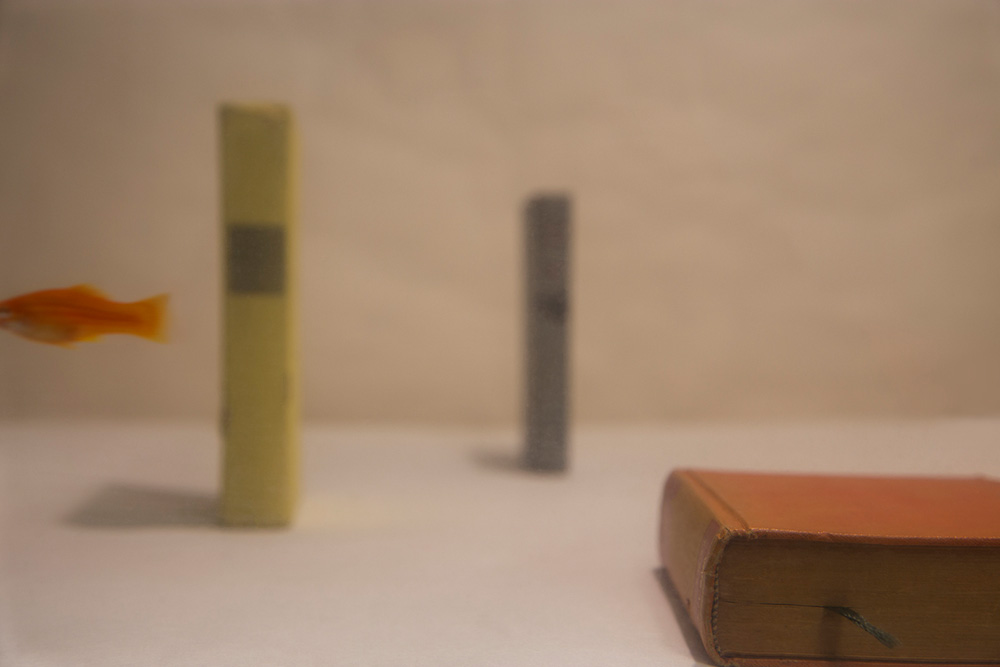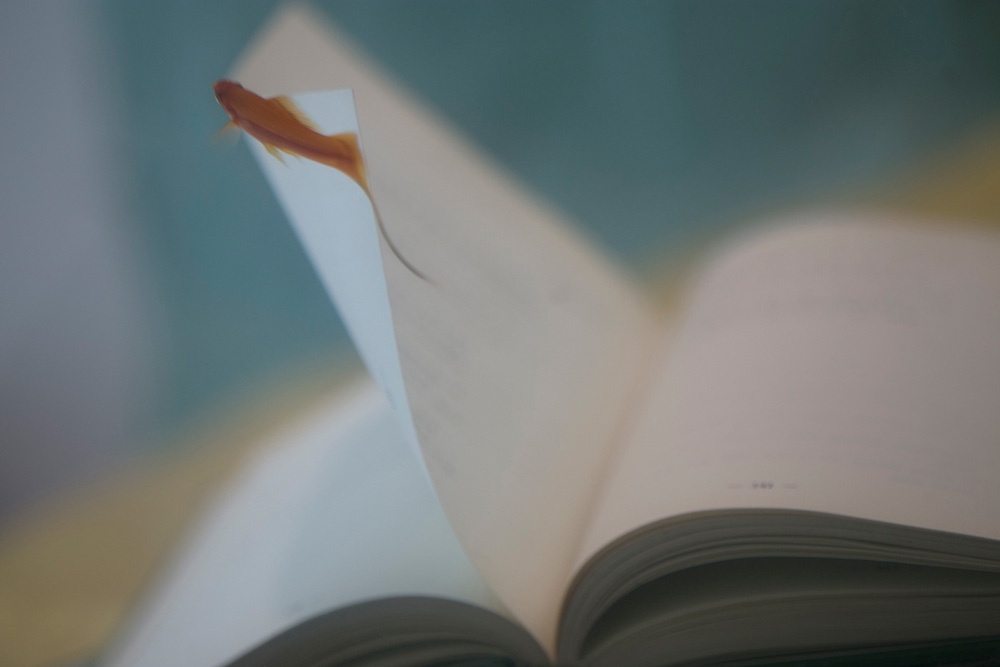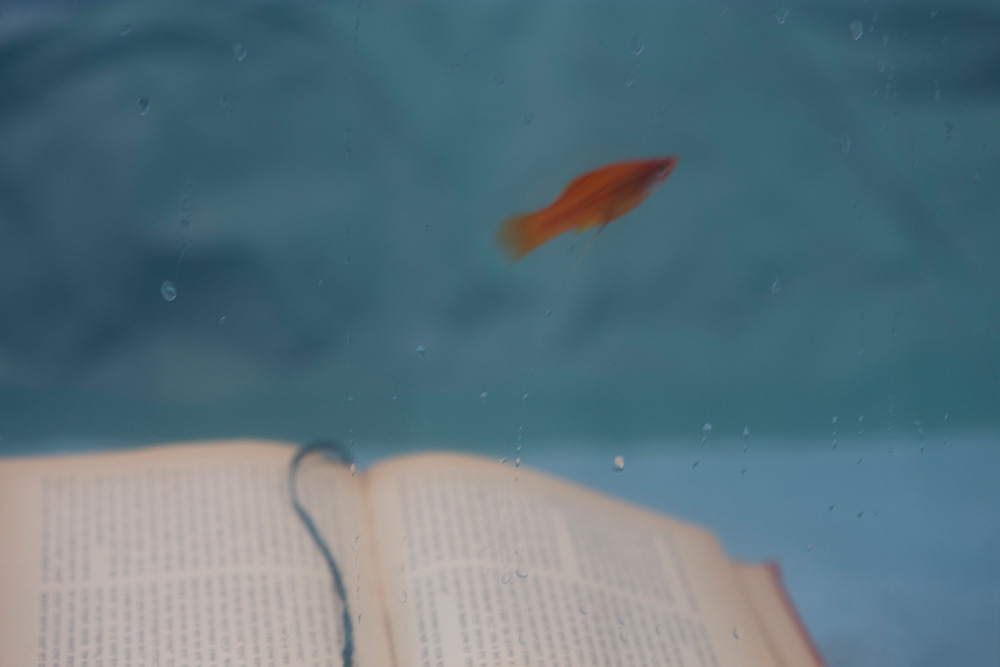안경희 작가의 작품은 무엇보다도 ‘책’ 이라는 소재를 통해 인간의 가장 아날로그적인 기록과 기억들이 조화를 이루는 구성의 단순미로 우리를 매혹시킨다. 넓고 고요한 여백에 동화된 화면은 종이를 물성으로 하는 사물에 대한 관찰로부터 미세한 농담을 빚어내고, 사진에 시적 영감을 부여한다. 작품엔 여타 작업들에서 쉽게 발견할 수 없는 묵도(默禱)의 세세한 감정이 녹아 있다. 그 안에 내재된 ‘정서의 자극’과 ‘감정의 일렁거림’으로 관객들은 어딘가 낯설지 않으면서 낯선 상태를 공유하게 되는 것이며, 가까운 듯 아득하게 느껴지는 것도 동일한 연유에 있다. 우리가 느끼는 공감의 순환, 그 본질도 바로 여기에 있으며 안경희 작가의 작품에 많은 이들이 눈길을 보내는 것도 같은 맥락에서이다. 특별히 이번 전시를 통해 새로운 신작 'silence reading' 및 'between'등을 발표한다. 10여년간 지속적으로 추구해온 사진이 가지고 있는 현대적인 미감을 또 다른 관점에서 맞볼 수 있는 기회가 될 것을 확신한다.
안경희-사라지는 책, 사라지는 추억
일정한 두께의 종이로 이루어진 책은 수많은 문자를 탑재하고 있다. 그 문자는 읽는 이들의 것으로 완성된다. 그러니 책은 늘 불안정하고 미완의 것으로 머문다. 누군가의 망막에 박혀 가독성의 것이 되기 전까지 책은 아직 미흡해 보이는 것이다. 모든 책은 유예된 문자이고 이야기이다. 온기를 지닌 한 사람의 손이 그 얇은 종이를 넘기면서 인쇄된 활자를 공들여 읽어나갈 때 비로소 책은 책이 된다. 책이 인간적인 이유는 그것이 내 살을 통해야 분명히 확인되며 눈으로 읽어나가야 내 것이 되고, 이후 기억이 되고 종래에는 내 몸의 일부가 되기 때문이다. 그러니 책을 읽는다는 것은 철저히 내 몸으로 밀고 나가는 일이다. 공들여 읽고 조심스레 밑줄을 치고 행간 사이에 혹은 여백의 문자를 기입하는 일은 경건한 의식과도 같다. 책을 읽으면서 나는 늘 새로운 인간으로 거듭난다. 그래서 지난 시절에 읽었던 책을 문득 조우할 때면 강렬한 추억에 사로잡히고 그 책을 읽었던 한 순간이 생생하게 부감된다. 물론 모든 사물은 그렇게 기억을 내장하고 있지만 책은 단일한 물체에 깃든 사물의 추억과는 다른 차원에서 작동한다.
안경희는 책을 소재로 사진촬영을 했다. 책이 오브제가 되었으며 자신의 의도에 따라 설치, 연출한 것이 사진으로 보여 진다. 책은 흡사 수조에 잠긴 것처럼 느리고 무겁게 가라앉은 후 마지못해 내지를 펼쳐 보인다. 흰 종이의 표면에 인쇄된 문자들은 망실되거나 드문드문 남아있다. 따라서 그 책은 온전히 읽을 수 없는 책이 되었다. 물살에 의해 혹은 바람에 따라 책장은 펼쳐지고 천천히 자신의 속살을 보여주고 있다. 마치 슬로우 모션으로 보는 영상과도 같다. 그 장면이 어딘지 애틋하고 슬프다. 책에 담긴 내용과 그것을 읽었던 이들의 기억이 함께 서서히 소멸되고 있는 것 같다. 원근이 사라진 적막한 평면의 공간에 책과 물고기 몇 마리만이 묘한 흐름과 운동성을 부여한다. 느리고 나른하다. 현실계와는 다른 차원에서 시간과 움직임이 펼쳐지는 것 같다. 그래서 보는 이들은 각자의 기억 속에 자리한 책장을 펼치는 환영에 사로잡힌다. 저 풍경은 무의식의 풍경, 추억 속의 풍경이다. 그래서 이질적인 두 개의 존재가 한 공간에 겹쳐있으며 사물의 윤곽은 물에 불었으며 이미지는 흐릿하다.
언젠가 내가 읽었던 책의 어느 한 페이지, 기억하고자 밑줄을 쳤던 문장, 지금은 가물가물해진 기억 속에 흘러 다니는 문자들, 그와 함께 그 책을 읽었던 시간 등이 서서히 사라져 버렸음을 문득 깨닫는다. 사진 속 책들은 대부분 누워있고 더러 서서 책등과 앞면을 보여준다. 책은 편안하게 누워서 자신을 이루는 낱낱의 종이들을 부드럽게 펼쳐준다. 사실 모든 책은 책상의 표면, 수평면과 일체가 되어야 자기 속살을 보여준다. 우리가 책으로 들어가기 위해서는 책을 눕혀야 한다. 그제야 수평이 된 책이 비로소 한 눈에 들어온다. 흐릿한 윤곽으로 인해 책장은 한 장씩 넘겨지고 있는 듯하다. 그 위로 주황색의 물고기가 유영하고 있다. 흰색의 종이(책)와 물고기의 붉은 색은 강한 대조를 이룬다. 모든 장면은 사뭇 몽환적이며 꿈속의 장면 또는 아련한 추억을 더듬는 듯한 느낌을 준다. 화면 전체는 축축하고 무겁고 투명한 질료인 물을 암시하며 그 안에 잠긴, 펼쳐진 책과 무심하게 떠다니는 물고기 몇 마리는 책과 관련된 개인적인 추억, ‘불안하게 떠도는 자아’(작가노트), 책과 자신의 관계를 보여준다. 그러나 한편으로 이 사진은 지식과 사유의 무기력함, 책으로 대변되는 온갖 지식의 덧없음을 암시하는 듯도 하다. 책은 깊은 바닥에 처연하게 가라앉아 있고 물고기들은 책을 등지고 무심하게 떠돌 뿐이다. 물고기에게 인간의 문자로 쓴 책은 무의미하다. 더구나 지워진 글자들, 숨 쉴 수 없는 물속, 부재하는 인간 등은 마치 모든 책이 사라지고 문자가 박탈되고 책에 관한 추억들이 사라지는 장면이기도 하다.
안경희는 사진이 주는 재현, 인증성과 선명함을 대신해서 흐릿하고 모호하게 대상을 보여준다. 그것은 불분명한 재현, 의도적인 은폐나 지우기다. 보이는 것보다는 비가시적인 것을 떠올려보게 하려는 의도일 것이다. 아울러 책에 바짝 다가간, 붙어나간 시선은 자신의 작업이 오로지 그 책이란 대상, 오브제로부터 연유하는 이야기와 관련되어 있음을 알려주고자 하는 그런 거리다. 근접한 시선은 또한 책이란 대상을 물질적인 존재로, 물성적 차원에서 감촉시킨다. 작가에게 책은 항상 관찰과 영감을 주는 대상이라고 한다. 종이라는 물성을 간직한 책만이 지닌 매력, 그리고 책은 평면과 입체를 동시에 간직한 공간이라는 사실, 아울러 책은 그 자체만으로도 충분한 아우라를 지니고 있다는 사실 등이 책을 오브제로 선택하게 된 이유라고 한다. 작가의 사진은 특정 책에 대한 아련한 기억 및 책이 지닌 아우라, 책을 통한 다양한 상상력이 가능한 공간을 가시화하기 위한 전략에서 출현한다. 결국 이 사진은 책에 대한 개인적 경험, 그에 대한 영감 등을 보여주려는 차원에서 이루어진 작업이고 여기서 책과 물고기는 자신의 자아, 기억 등을 대신하는 상징이 된다. 무엇보다도 사라져버린 모든 것들에 대한 애도의 시선이 저 흔들리는 책의 낱장에 가득 서려있는 안경희의 사진은 인간에게 책이란 존재는 무엇인가를, 무엇이었는가를 질문하고 있다.
박영택 (경기대교수, 미술평론가)
일정한 두께의 종이로 이루어진 책은 수많은 문자를 탑재하고 있다. 그 문자는 읽는 이들의 것으로 완성된다. 그러니 책은 늘 불안정하고 미완의 것으로 머문다. 누군가의 망막에 박혀 가독성의 것이 되기 전까지 책은 아직 미흡해 보이는 것이다. 모든 책은 유예된 문자이고 이야기이다. 온기를 지닌 한 사람의 손이 그 얇은 종이를 넘기면서 인쇄된 활자를 공들여 읽어나갈 때 비로소 책은 책이 된다. 책이 인간적인 이유는 그것이 내 살을 통해야 분명히 확인되며 눈으로 읽어나가야 내 것이 되고, 이후 기억이 되고 종래에는 내 몸의 일부가 되기 때문이다. 그러니 책을 읽는다는 것은 철저히 내 몸으로 밀고 나가는 일이다. 공들여 읽고 조심스레 밑줄을 치고 행간 사이에 혹은 여백의 문자를 기입하는 일은 경건한 의식과도 같다. 책을 읽으면서 나는 늘 새로운 인간으로 거듭난다. 그래서 지난 시절에 읽었던 책을 문득 조우할 때면 강렬한 추억에 사로잡히고 그 책을 읽었던 한 순간이 생생하게 부감된다. 물론 모든 사물은 그렇게 기억을 내장하고 있지만 책은 단일한 물체에 깃든 사물의 추억과는 다른 차원에서 작동한다.
안경희는 책을 소재로 사진촬영을 했다. 책이 오브제가 되었으며 자신의 의도에 따라 설치, 연출한 것이 사진으로 보여 진다. 책은 흡사 수조에 잠긴 것처럼 느리고 무겁게 가라앉은 후 마지못해 내지를 펼쳐 보인다. 흰 종이의 표면에 인쇄된 문자들은 망실되거나 드문드문 남아있다. 따라서 그 책은 온전히 읽을 수 없는 책이 되었다. 물살에 의해 혹은 바람에 따라 책장은 펼쳐지고 천천히 자신의 속살을 보여주고 있다. 마치 슬로우 모션으로 보는 영상과도 같다. 그 장면이 어딘지 애틋하고 슬프다. 책에 담긴 내용과 그것을 읽었던 이들의 기억이 함께 서서히 소멸되고 있는 것 같다. 원근이 사라진 적막한 평면의 공간에 책과 물고기 몇 마리만이 묘한 흐름과 운동성을 부여한다. 느리고 나른하다. 현실계와는 다른 차원에서 시간과 움직임이 펼쳐지는 것 같다. 그래서 보는 이들은 각자의 기억 속에 자리한 책장을 펼치는 환영에 사로잡힌다. 저 풍경은 무의식의 풍경, 추억 속의 풍경이다. 그래서 이질적인 두 개의 존재가 한 공간에 겹쳐있으며 사물의 윤곽은 물에 불었으며 이미지는 흐릿하다.
언젠가 내가 읽었던 책의 어느 한 페이지, 기억하고자 밑줄을 쳤던 문장, 지금은 가물가물해진 기억 속에 흘러 다니는 문자들, 그와 함께 그 책을 읽었던 시간 등이 서서히 사라져 버렸음을 문득 깨닫는다. 사진 속 책들은 대부분 누워있고 더러 서서 책등과 앞면을 보여준다. 책은 편안하게 누워서 자신을 이루는 낱낱의 종이들을 부드럽게 펼쳐준다. 사실 모든 책은 책상의 표면, 수평면과 일체가 되어야 자기 속살을 보여준다. 우리가 책으로 들어가기 위해서는 책을 눕혀야 한다. 그제야 수평이 된 책이 비로소 한 눈에 들어온다. 흐릿한 윤곽으로 인해 책장은 한 장씩 넘겨지고 있는 듯하다. 그 위로 주황색의 물고기가 유영하고 있다. 흰색의 종이(책)와 물고기의 붉은 색은 강한 대조를 이룬다. 모든 장면은 사뭇 몽환적이며 꿈속의 장면 또는 아련한 추억을 더듬는 듯한 느낌을 준다. 화면 전체는 축축하고 무겁고 투명한 질료인 물을 암시하며 그 안에 잠긴, 펼쳐진 책과 무심하게 떠다니는 물고기 몇 마리는 책과 관련된 개인적인 추억, ‘불안하게 떠도는 자아’(작가노트), 책과 자신의 관계를 보여준다. 그러나 한편으로 이 사진은 지식과 사유의 무기력함, 책으로 대변되는 온갖 지식의 덧없음을 암시하는 듯도 하다. 책은 깊은 바닥에 처연하게 가라앉아 있고 물고기들은 책을 등지고 무심하게 떠돌 뿐이다. 물고기에게 인간의 문자로 쓴 책은 무의미하다. 더구나 지워진 글자들, 숨 쉴 수 없는 물속, 부재하는 인간 등은 마치 모든 책이 사라지고 문자가 박탈되고 책에 관한 추억들이 사라지는 장면이기도 하다.
안경희는 사진이 주는 재현, 인증성과 선명함을 대신해서 흐릿하고 모호하게 대상을 보여준다. 그것은 불분명한 재현, 의도적인 은폐나 지우기다. 보이는 것보다는 비가시적인 것을 떠올려보게 하려는 의도일 것이다. 아울러 책에 바짝 다가간, 붙어나간 시선은 자신의 작업이 오로지 그 책이란 대상, 오브제로부터 연유하는 이야기와 관련되어 있음을 알려주고자 하는 그런 거리다. 근접한 시선은 또한 책이란 대상을 물질적인 존재로, 물성적 차원에서 감촉시킨다. 작가에게 책은 항상 관찰과 영감을 주는 대상이라고 한다. 종이라는 물성을 간직한 책만이 지닌 매력, 그리고 책은 평면과 입체를 동시에 간직한 공간이라는 사실, 아울러 책은 그 자체만으로도 충분한 아우라를 지니고 있다는 사실 등이 책을 오브제로 선택하게 된 이유라고 한다. 작가의 사진은 특정 책에 대한 아련한 기억 및 책이 지닌 아우라, 책을 통한 다양한 상상력이 가능한 공간을 가시화하기 위한 전략에서 출현한다. 결국 이 사진은 책에 대한 개인적 경험, 그에 대한 영감 등을 보여주려는 차원에서 이루어진 작업이고 여기서 책과 물고기는 자신의 자아, 기억 등을 대신하는 상징이 된다. 무엇보다도 사라져버린 모든 것들에 대한 애도의 시선이 저 흔들리는 책의 낱장에 가득 서려있는 안경희의 사진은 인간에게 책이란 존재는 무엇인가를, 무엇이었는가를 질문하고 있다.
An Kyunghee: Vanishing Books, Vanishing Memories
A book, made up of sheets of paper with the same thickness, contains numerous characters. These characters become complete when read by readers. The book, therefore, is destined to remain unstable and incomplete. It appears to have something missing before it falls on someone’s retina as an object of reading. All books are postponed characters and stories. Books become books only after a warm human hand turns the thin pages to carefully read the printed characters. Books have human aspects because they are fully recognized through my flesh. They become mine when I read them with my own eyes. Then they become memories and, in the end, part of my body. In other words, reading books means carrying it through with my own body. It is like a solemn ritual to attentively read, carefully underline the words, and put additional words between lines or in the margin. I am born again as a new being whenever I read books. So when I unexpectedly encounter the books that I read in the past, I am consumed with intense memories and feel the very moment when I read the book emerge vividly. Of course, all objects contain memories, but the memories reflected in books work in a different way from those related with a single object.
An Kyunghee photographed books. Books are the objets, which seem to have been installed and arranged deliberately. The books sink slowly and heavily as if they are in a water tank and then open and reveal their inside pages reluctantly. On some white pages, printed characters have been completely gone. On some others, some surviving characters are found sparsely. Therefore, the books are not to be read as a whole. When the pages are turned by waves or winds, they slowly reveal what they have inside. It is like a slow-motion video image. This image is somehow bitter and sad. It looks as though the stories in the books and the memories of their readers are dissipating together. The books and a few fish are the only thing that gives a sense of mysterious flow and mobility to the two-dimensional space where perspective has gone. It feels slow and listless. It also feels as if time and movement here were working in a dimension that is different from the real world. For this reason, viewers experience illusions that they turn the pages of the books in their memories. The image in the photo is that of the unconscious and memories. This is why the two very different things are overlapping each other in the same space with the outlines of the objects swollen with water, and the image is hazy.
All of a sudden, I realize that the pages that I read, sentences that I underlined to remember, characters that are drifting in my blurred memories, and the time that I spent reading the books have slowly disappeared. Most of the books in the photograph are lying, while some are standing, showing the front or back. Books lie down comfortably to smoothly open their pages one by one. All books in fact can reveal their bare skin only when they become united with the horizontal surface of the desk. We should lay down the book if we hope to go inside the book. This is when the horizontally-laid book comes into sight as a whole. The foggy outlines make it look as if the pages are being turned one by one. Over the books are orange-colored fish swimming. The white color of the books and the orange color of the fish make a strong contrast. All images are quite dreamlike, making viewers feel as if they are going over images in their dreams or dim memories. The overall image implies water, which is a moist, heavy, and transparent substance. The open books and fish swimming nonchalantly represent personal memories related to books, “the ego floating unstably” (from [Artist’s Note]), and the relationship between the book and the self. At the same time, however, this photograph appears to suggest the helplessness of knowledge and thinking and the transience of all types of knowledge often represented by books. The books are pitifully lying sunk at the bottom, and the fish are swimming around indifferently with their backs against the books. Books full of human characters are meaningless to fish. Furthermore, the erased letters, the underwater space where one cannot breathe, and the absence of humans represent a situation where all books disappear, characters are removed, and book-related memories vanish.
An Kyunghee describes objects in a vague and blurry manner rather than using the nature of photography that represents, confirms, and clarify things. Her work is unclear representation and intentional concealment and removal. She might have intended to emphasize invisible things instead of visible things. In addition, her eyes remaining close to the books suggests the distance that she maintained to show her work is only related to stories stemming from the objet of books. Her close view makes books felt as a physical object in terms of its property. She explains that books always make her observe things and inspire her. She adds that she chose books as an objet because of the charm unique to books that include the property of paper and the fact that books serve as a space that are both two-dimensional and three-dimensional and that books themselves have a strong aura. Her photograph starts from a strategy to visualize dim memories of certain books, the aura of books, and a space where anything can be imagined through books. In other words, this photograph was intended to express her personal experiences related to books and associated inspirations, and the books and fish symbolize the self and memories. Most importantly, the pages of the books are filled with her mourning for all things that have gone away, which is how her photograph asks us what books used to be and are to humans.
Park Young-taek (Professor at Kyonggi University, art critic)
A book, made up of sheets of paper with the same thickness, contains numerous characters. These characters become complete when read by readers. The book, therefore, is destined to remain unstable and incomplete. It appears to have something missing before it falls on someone’s retina as an object of reading. All books are postponed characters and stories. Books become books only after a warm human hand turns the thin pages to carefully read the printed characters. Books have human aspects because they are fully recognized through my flesh. They become mine when I read them with my own eyes. Then they become memories and, in the end, part of my body. In other words, reading books means carrying it through with my own body. It is like a solemn ritual to attentively read, carefully underline the words, and put additional words between lines or in the margin. I am born again as a new being whenever I read books. So when I unexpectedly encounter the books that I read in the past, I am consumed with intense memories and feel the very moment when I read the book emerge vividly. Of course, all objects contain memories, but the memories reflected in books work in a different way from those related with a single object.
An Kyunghee photographed books. Books are the objets, which seem to have been installed and arranged deliberately. The books sink slowly and heavily as if they are in a water tank and then open and reveal their inside pages reluctantly. On some white pages, printed characters have been completely gone. On some others, some surviving characters are found sparsely. Therefore, the books are not to be read as a whole. When the pages are turned by waves or winds, they slowly reveal what they have inside. It is like a slow-motion video image. This image is somehow bitter and sad. It looks as though the stories in the books and the memories of their readers are dissipating together. The books and a few fish are the only thing that gives a sense of mysterious flow and mobility to the two-dimensional space where perspective has gone. It feels slow and listless. It also feels as if time and movement here were working in a dimension that is different from the real world. For this reason, viewers experience illusions that they turn the pages of the books in their memories. The image in the photo is that of the unconscious and memories. This is why the two very different things are overlapping each other in the same space with the outlines of the objects swollen with water, and the image is hazy.
All of a sudden, I realize that the pages that I read, sentences that I underlined to remember, characters that are drifting in my blurred memories, and the time that I spent reading the books have slowly disappeared. Most of the books in the photograph are lying, while some are standing, showing the front or back. Books lie down comfortably to smoothly open their pages one by one. All books in fact can reveal their bare skin only when they become united with the horizontal surface of the desk. We should lay down the book if we hope to go inside the book. This is when the horizontally-laid book comes into sight as a whole. The foggy outlines make it look as if the pages are being turned one by one. Over the books are orange-colored fish swimming. The white color of the books and the orange color of the fish make a strong contrast. All images are quite dreamlike, making viewers feel as if they are going over images in their dreams or dim memories. The overall image implies water, which is a moist, heavy, and transparent substance. The open books and fish swimming nonchalantly represent personal memories related to books, “the ego floating unstably” (from [Artist’s Note]), and the relationship between the book and the self. At the same time, however, this photograph appears to suggest the helplessness of knowledge and thinking and the transience of all types of knowledge often represented by books. The books are pitifully lying sunk at the bottom, and the fish are swimming around indifferently with their backs against the books. Books full of human characters are meaningless to fish. Furthermore, the erased letters, the underwater space where one cannot breathe, and the absence of humans represent a situation where all books disappear, characters are removed, and book-related memories vanish.
An Kyunghee describes objects in a vague and blurry manner rather than using the nature of photography that represents, confirms, and clarify things. Her work is unclear representation and intentional concealment and removal. She might have intended to emphasize invisible things instead of visible things. In addition, her eyes remaining close to the books suggests the distance that she maintained to show her work is only related to stories stemming from the objet of books. Her close view makes books felt as a physical object in terms of its property. She explains that books always make her observe things and inspire her. She adds that she chose books as an objet because of the charm unique to books that include the property of paper and the fact that books serve as a space that are both two-dimensional and three-dimensional and that books themselves have a strong aura. Her photograph starts from a strategy to visualize dim memories of certain books, the aura of books, and a space where anything can be imagined through books. In other words, this photograph was intended to express her personal experiences related to books and associated inspirations, and the books and fish symbolize the self and memories. Most importantly, the pages of the books are filled with her mourning for all things that have gone away, which is how her photograph asks us what books used to be and are to humans.
안경희 An, Kyunghee
[개인전]
2015 .01 갤러리 라메르 초대기획전 'BOOK' / 서울, 갤러리 라메르
2013, 10 Another Story / 서울, 갤러리 썬
2012. 11 편지-아빠로부터(1966-1971) / 서울, 이랜드스페이스
2012. 08 안경희 초대전 (책: 울림) / 서울, 더 스트릿 갤러리(GS타워)
2011. 10 안경희의 책冊.상想 展 / 서울, 신당창작아케이드
2011. 03 2011 KCAF / 서울, 예술의 전당 한가람미술관
2011. 03 the BOOK 展 / 서울, 진선북카페 프로젝트
2011, 01 BEYOND the BOOKS 展 / 서울, 서교예술실험센터
2010. 06 BOOK & BOOKs 展 / 서울, 갤러리 라메르
[단체전]
2014. 05 Clunes Book Festival May 2014 / Australia, Clune
2014. 05 서울오픈아트페어2013 / 서울, 코엑스
2013. 05 서울오픈아트페어2013 / 서울, 코엑스
2012. 02 1 o'clock herd of juggling / Seoul, Insa Art Space
2011. 07 Chacgado / Seoul, Yaesong art museum
2011. 05 SPRING STORY 展 / 서울, 박영덕화랑
2011. 04 2011 SEOUL PHOTO FAIR / 서울,코엑스
[수상]
2010 캐논서바이벌사진콘테스트 대상
Finalist for the 2014-15 Studio Residency Grant at WSW Studio Residency, Newyork
[프로그램]
2011 이랜드문화재단 2기 작가공모 선정
2011 아르코 하반기 작가성장프로그램 선정
2009~ 현재 서울시창작공간 신당창작아케이드 입주
[개인전]
2015 .01 갤러리 라메르 초대기획전 'BOOK' / 서울, 갤러리 라메르
2013, 10 Another Story / 서울, 갤러리 썬
2012. 11 편지-아빠로부터(1966-1971) / 서울, 이랜드스페이스
2012. 08 안경희 초대전 (책: 울림) / 서울, 더 스트릿 갤러리(GS타워)
2011. 10 안경희의 책冊.상想 展 / 서울, 신당창작아케이드
2011. 03 2011 KCAF / 서울, 예술의 전당 한가람미술관
2011. 03 the BOOK 展 / 서울, 진선북카페 프로젝트
2011, 01 BEYOND the BOOKS 展 / 서울, 서교예술실험센터
2010. 06 BOOK & BOOKs 展 / 서울, 갤러리 라메르
[단체전]
2014. 05 Clunes Book Festival May 2014 / Australia, Clune
2014. 05 서울오픈아트페어2013 / 서울, 코엑스
2013. 05 서울오픈아트페어2013 / 서울, 코엑스
2012. 02 1 o'clock herd of juggling / Seoul, Insa Art Space
2011. 07 Chacgado / Seoul, Yaesong art museum
2011. 05 SPRING STORY 展 / 서울, 박영덕화랑
2011. 04 2011 SEOUL PHOTO FAIR / 서울,코엑스
[수상]
2010 캐논서바이벌사진콘테스트 대상
Finalist for the 2014-15 Studio Residency Grant at WSW Studio Residency, Newyork
[프로그램]
2011 이랜드문화재단 2기 작가공모 선정
2011 아르코 하반기 작가성장프로그램 선정
2009~ 현재 서울시창작공간 신당창작아케이드 입주
An, Kyunghee
Solo exhibition
2015 .01 'BOOK' / Seoul, gallery LAMER
2013.10 Another story / Seoul, gallery SUN
2012. 11 The Letter _ from Dad (1966-1971) / Seoul, E-LAND SPACE
2012. 08 the Book ; echo / Seoul, The Street gallery
2011. 10 Kyunghee AN’ s Desk / Seoul, Seoul Art Space SINDANG
2011.03 2011 KCAF / Seoul, Seoul Arts Center Hangaram art museum
2011. 03 the BOOK / Seoul, gallery JINSUN
2011. 01 Beyond the books / Seoul, Seoul Art Space SEOGYO
2010. 06 BOOK &BOOKs / Seoul, gallery LAMER
2008, 2009, 2010 Seoul International bookarts fair / Seoul, COEX
Award
2010 12 Canon Reality Survival Contest - grand prize
2009, 2008, 2006 Seoul International Bookarts Contest - finalist
Residency
2009~ Seoul Art Space SINDANG
Possession of work
National Museum of Modern and Contemporary Art, Korea
E-LAND Art Space
Solo exhibition
2015 .01 'BOOK' / Seoul, gallery LAMER
2013.10 Another story / Seoul, gallery SUN
2012. 11 The Letter _ from Dad (1966-1971) / Seoul, E-LAND SPACE
2012. 08 the Book ; echo / Seoul, The Street gallery
2011. 10 Kyunghee AN’ s Desk / Seoul, Seoul Art Space SINDANG
2011.03 2011 KCAF / Seoul, Seoul Arts Center Hangaram art museum
2011. 03 the BOOK / Seoul, gallery JINSUN
2011. 01 Beyond the books / Seoul, Seoul Art Space SEOGYO
2010. 06 BOOK &BOOKs / Seoul, gallery LAMER
2008, 2009, 2010 Seoul International bookarts fair / Seoul, COEX
Award
2010 12 Canon Reality Survival Contest - grand prize
2009, 2008, 2006 Seoul International Bookarts Contest - finalist
Residency
2009~ Seoul Art Space SINDANG
Possession of work
National Museum of Modern and Contemporary Art, Korea
E-LAND Art Space


